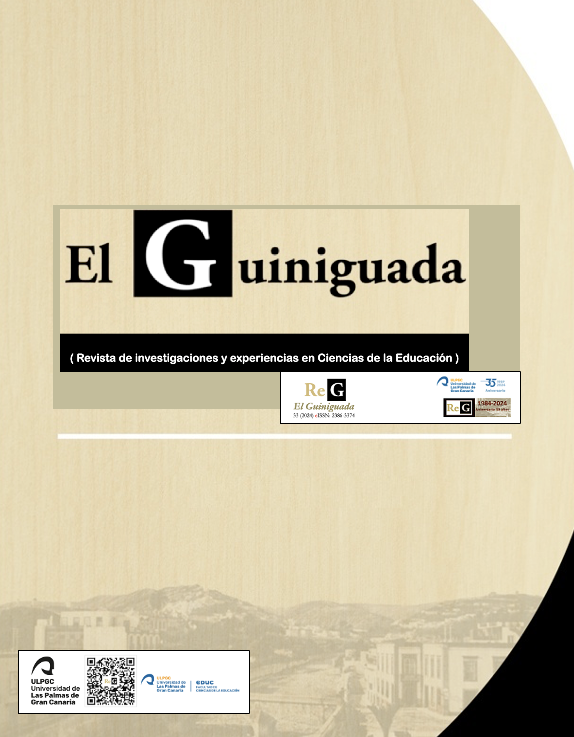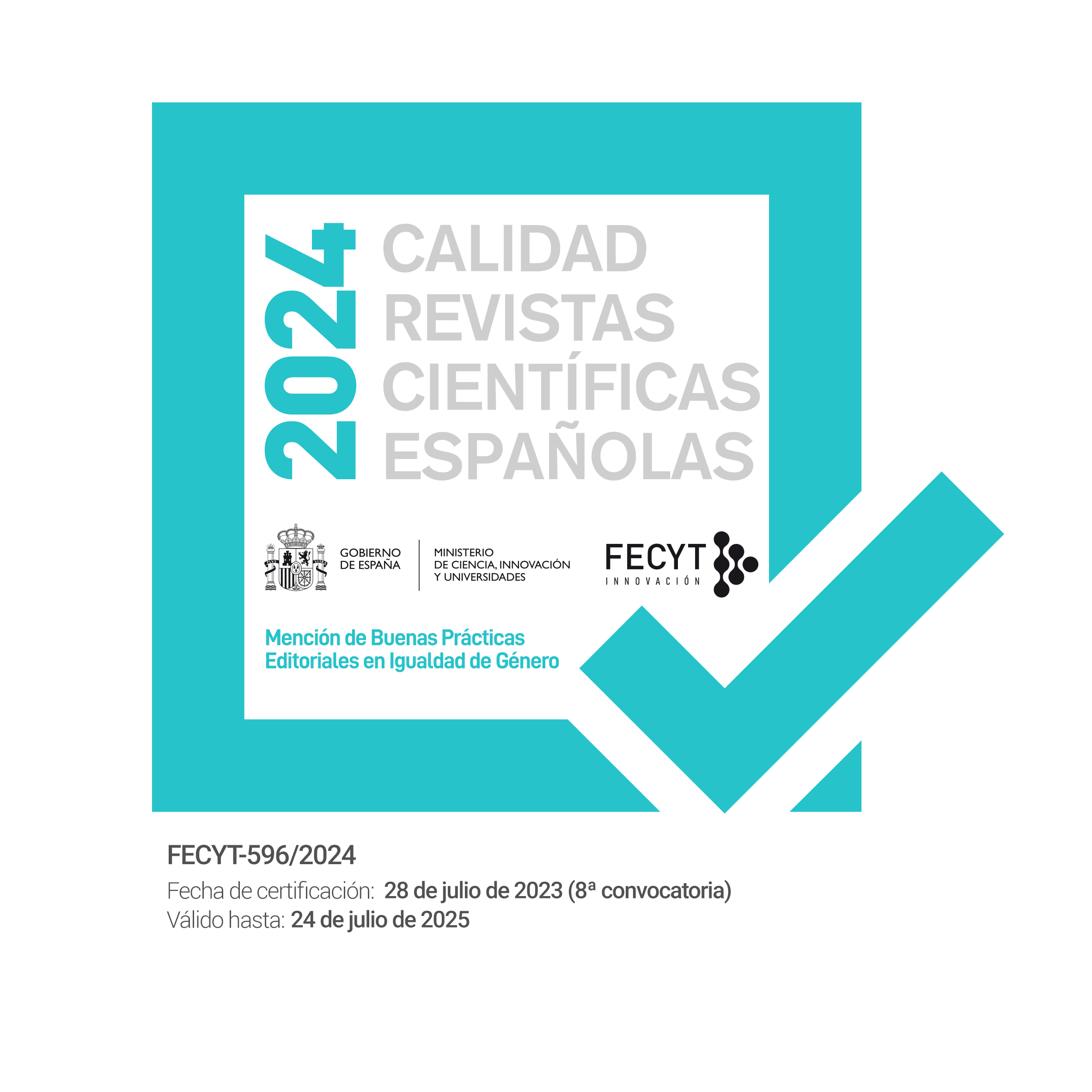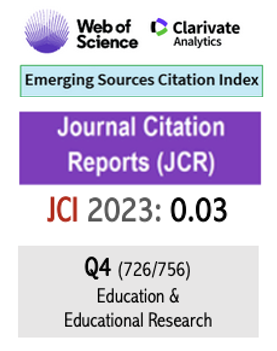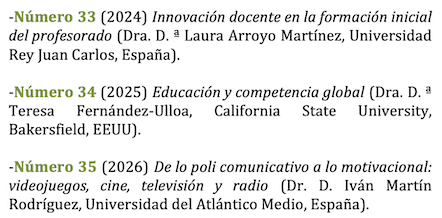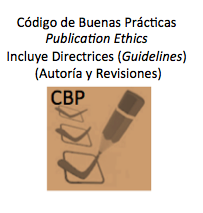Speech Disfluencies in Spanish-speaking Students of Chinese Origin from the EEE-8
10.20420/ElGuiniguada.2024.721
Keywords:
DISFLUENCIAS DEL HABLA, ESTRATEGIA DE COMUNICACIÓN, ESTUDIANTES SINOHABLANTES, PAUSASAbstract
For this study, we choosed randomly 347 speeches from the oral translation test of the Spanish as a Speciality Exam held in China in 2019 to analyze the disfluencies made by Chinese students who are on the verge of graduating from the Hispanic Philology degree. The findings revealed that sound pauses were the most common form (55.83%), followed by silent pauses (15.18%), phonetic self-correction (9.57%), partial repetition (8.54%), complete repetition (6.06%), and lexical self-correction (4.82%).
Downloads
References
Bortfeld, H., Leon, S. D., Brennan, S. E., Bloom, J. E., y Schober, M. F. (2001). Disfluency Rates in Conversation: Effects of Age, Relationship, Topic, Role, and Gender. Language and Speech 44, 123–147.
Cestero, A. M. (2000). El intercambio de turnos de habla en la conversación. Alcalá: Editorial Universidad de Alcalá. https://linred.web.uah.es/monograficos_pdf/LR_monografico14-articulo8.pdf
Chomsky, N. (1965). Aspects of the theory of syntax. Cambridge: MIT Press.
Clark, H. H. (1996). Using language. Cambridge: Cambridge University Press.
Clark, H. H., y Fox Tree, J. E. (2002). Using uh and um in spontaneous speech. Cognition 84, 73–111. https://www.sciencedirect.com/science/article/abs/pii/S0010027702000173
Corley, M., y Hartsuiker, R. J. (2011). Why um helps auditory word recognition: The temporal delay hypothesis. PLoS One 6(5), e19792. https://journals.plos.org/plosone/article?id=10.1371/journal.pone.0019792
Corley, M., y Stewart, O. W. (2008). Hesitation Disfluencies in Spontaneous Speech: The Meaning of um. Language and Linguistic Compass 2(4), 589–602. https://compass.onlinelibrary.wiley.com/doi/10.1111/j.1749-818X.2008.00068.x
Dai, Ch. (2011). A Study on Disfluency in Chinese to English Interpretations of Chinese EFL Learners. Shanghai Journal of Translation 1, 38–43.
Duan, M. (2020). Vowel frequencies in English and Chinese lexicons. Language Teaching and Linguistic Studies 202(2), 33–40.
Fox Tree, J. E. (1995). The Effects of False Starts and Repetitions on the Processing of Subsequent Words in Spontaneous Speech. Journal of Memory and Language 34, 709–738. https://www.sciencedirect.com/science/article/abs/pii/S0749596X85710327
Fraundorf, S. H., y Watson, D. G. (2014). Alice’s Adventures in Um-Derland: Psycholinguistic Sources of Variation in Disfluency Production. Language, Cognition and Neuroscience 29, 1083–1096. https://www.ncbi.nlm.nih.gov/pmc/articles/PMC4203439/
Gbadegesin, M. O. (2018). Hesitation as Gender Marker: A Discourse Intonation Approach. International Journal for Innovative Research in Multidisciplinary Field 4(10), 88–95. https://www.ijirmf.com/wp-content/uploads/201810014.pdf
Giannini, A. (2003). Hesitation Phenomena in Spontaneous Italian. Proceedings of the 15th International Congress of Phonetic Sciences, 2653–2656. https://www.internationalphoneticassociation.org/icphs-proceedings/ICPhS2003/papers/p15_2653.pdf
Gkalitsiou, Z., Byrd, C. T., Bedore, L. M., y Taliancich-Klinger, C. L. (2017). Stuttering on Function Words in Bilingual Children who Stutter: A Preliminary Study. Clinical Linguistics and Phonetics 31, 1–16. https://moody.utexas.edu/sites/default/files/Stuttering%20on%20function%20words%20in%20bilingual%20children_2017.pdf
Hartsuiker, R. J., Pickering, M. J., y De Jong, N. (2005). Semantic and phonological context effects in speech error repair. Journal of Experimental Psychology: Learning, Memory, and Cognition 31(5), 921–932. https://psycnet.apa.org/record/2005-13211-007
Hartsuiker, R. J., y Kolk, H. H. J. (2001). Error monitoring in speech production: A computational test of the perceptual loop theory. Cognitive Psychology 42, 113–157. https://www.sciencedirect.com/science/article/abs/pii/S0010028500907448
Kjellmer, G. (2003). Hesitation in defence of er and erm. English Studies 84(2), 170–198. https://www.tandfonline.com/doi/abs/10.1076/enst.84.2.170.14903
Kovac, M. M. (2016). Repetitions as a communication strategy: A case study. Studies in English Language Teaching 4(1), 87–103. http://www.scholink.org/ojs/index.php/selt/article/view/476
Levelt, W. J. M. (1989). Speaking: from intention to articulation. Cambridge: MIT Press.
Liu, Ch. (1999). A brief discussion on the differentiation of nasal sounds before and after vowels in Mandarin. Journal of Taizhou University 2, 93–94.
López-Ozieblo, R. (2015). Análisis de disfluencias y gestos en nativos españoles y en alumnos de español como lengua extranjera, tesis doctoral, Universidad de Málaga. https://riuma.uma.es/xmlui/handle/10630/11747
Ma, D. (2012). Study on the Taxonomy of Disfluencies in Oral Production. Foreign Languages and Their Teaching 4, 30–34.
Machuca, M. J., Llisterri, J., y Ríos, A. (2015). Las pausas sonoras y los alargamientos en español: un estudio preliminar. Normas. Revista de Estudios Lingüísticos Hispánicos 5, 81–96. https://ojs.uv.es/index.php/normas/article/view/6823/0
Nicholson, H., Eberhard, K., Scheutz, M. (2010). “um...i don’t see any”: the function of filled pauses and repairs. Proceedings of DiSS-LPSS Joint Workshop, 89–92. https://hrilab.tufts.edu/publications/nicholsonetal10diss.pdf
Qiao, Q. (2003). The evolution of nasal initials in Shanxi dialect. Journal of Shanxi University 4, 78–81.
Parra Reyes, D., y Grande Tolentino, P. I. (2019). Perfil de la fluidez del habla en niños de 8 y 9 años en Santa Anita. Alétheia 7, 45–52. https://revistas.unife.edu.pe/index.php/aletheia/article/view/2152
Pons Bordería, Salvador (dir.). Corpus Val.Es.Co 3.0. <http://www.valesco.es> [25/11/2023]
Richards, J. C., y Schmidt, R. (2010). Longman Dictionary of Language Teaching and Applied Linguistics (4.a ed.). London: Routledge.
Rojas Contreras, D., Román Montes de Oca, D., Quezada Gaponov, C., y Pino Castillo, J. (2020). Disfluencias típicas del habla en niños fluentes de Santiago de Chile. Revista Chilena de Fonoaudiología 19, 1–11. https://revfono.uchile.cl/index.php/RCDF/article/view/60194
Rühlemann, C., Bagoutdinov, A., y O’Donnell, M. (2011). Windows on the mind: Pauses in conversational narrative. International Journal of Corpus Linguistics 16(2), 198–232. https://www.uni-marburg.de/de/fb10/iaa/institut/personen/ruehlemann/pauses_in_narrative-_bct.pdf
Schegloff, E., Jefferson G., y Sacks, H. (1977). The Preference for Self- Correction in the Organization of Repair in Conversation. Language 53(2), 361–382. https://www.jstor.org/stable/413107
Stepanova, S. (2007). Some features of filled hesitation pauses in spontaneous Russian. Proceedings of ICPhS, 1325–1328. http://www.icphs2007.de/conference/Papers/1261/1261.pdf
Tottie, G. (2011). Uh and um as sociolinguistic markers in British English. The International Journal of Corpus Linguistics 16, 173–196.
Wang, X., y Jin, X. (2020). A Study of Non-fluent Filled Pause among Chinese L2 Learners. Journal of Northeast Normal University 304, 84–92.
Published
How to Cite
Issue
Section
License
Copyright (c) 2024 Yang Song

This work is licensed under a Creative Commons Attribution-NonCommercial-NoDerivatives 4.0 International License.
Authors who publish with this journal agree to the following terms:
- Authors retain copyright and grant the journal right of first publication with the work simultaneously licensed under a Creative Commons Attribution License that allows others to share the work with an acknowledgement of the work's authorship and initial publication in this journal. You can not make a commercial use of the work. The use derived from the work is also not allowed.
- Authors are able to enter into separate, additional contractual arrangements for the non-exclusive distribution of the journal's published version of the work (e.g., post it to an institutional repository or publish it in a book), with an acknowledgement of its initial publication in this journal.
- Authors are permitted and encouraged to post their work online (e.g., in institutional repositories or on their website) prior to and during the submission process, as it can lead to productive exchanges, as well as earlier and greater citation of published work (See The Effect of Open Access).
